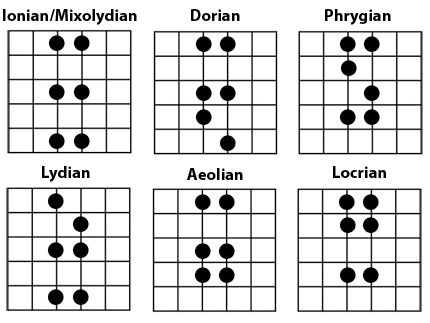Been looking for a simple way to incorporate seventh chord arpeggios into your playing? Or maybe you’ve noticed that all your shapes start on the root and you’re looking to mix things up with some inversions? Well, this lesson has you covered. It’s a simple approach to seventh chord arpeggios using familiar, three-note-per-string modal shapes.
You’ve probably seen/used these shapes before, they look like this:

Note that we’re only using one shape for Ionian and Mixolydian, that’s because the only difference between the two is the 7th, and it doesn’t show up on the first two strings for these shapes.
What we’re going to do is make a formula for which notes in these shapes to play, and what sort of seventh chords those formulas create. We’ll number the notes, in ascending order, by number. So each voicing has six notes, numbered 1-6. The first formula is 1 – 3 – 5 – 6. So if we take the Ionian/Mixolydian shape, and start it at the 5th fret (A), we’ll be playing A C# E F#, which is an F#-7 (1st inversion).

Now take that same formula and try it with the Aeolian mode shape. Now you have A C E F… an FΔ7 (1st inversion). How about Locrian? A C Eb F… F7 (1st inversion). Now you’re probably noticing the pattern. 1 – 3 – 5 – 6 with these shapes will always give you some sort of 1st inversion 7th chord. How do you remember that? Well, if you’re familiar with figured bass, you’ll recognize that a 1st inversion 7th chord is indicated by 6/5. If you don’t know what figured bass means, you can read up on it here or you can just memorize this stuff. Whichever you prefer is fine (although understanding figured bass is probably the better way to go).
So what about 2nd and 3rd inversion arpeggios? Well, they’ve got simple formulas too. They are 1 – 3 – 4 – 6 for 2nd inversion (note that in figured bass this is indicated by 4/3), and 1 – 2 – 4 – 6 for 3rd (indicated in figured bass by 4/2). Here is a chart of all the inversions for each of the 4 types of 7th chords found in the major modes utilizing this approach:

What’s great about these shapes is that it’s really easy to move them up or down in octaves to create really cool extended arpeggios. A couple of my favorite shapes are the 1st and 3rd inversion dominant shapes. I like these ones because it’s really simple to move up or down a tritone each time I change a string. Dominant chords are just cool in general though… so there’s that.
I have not yet noticed any pattern for remembering which modes yield which arpeggios. Personally, I am able to look at the shape and identify which chords they are. I can also recognize them aurally. If you just remember which note is the root in each shape, you should be able to figure out what type of arpeggio you’re playing. Eventually, you’ll come to the point where you simply know.
